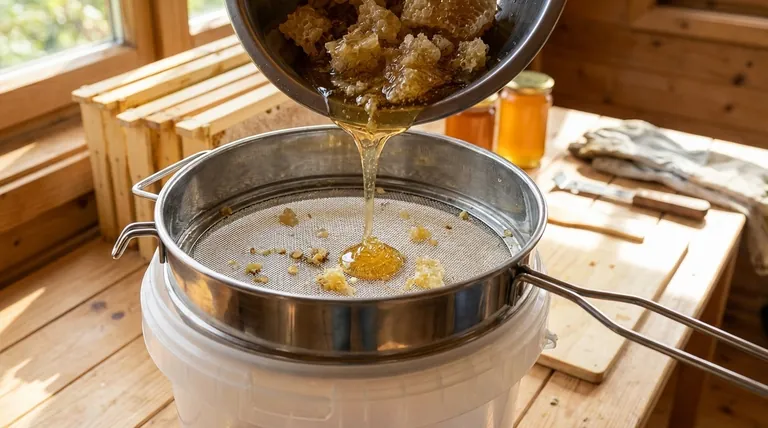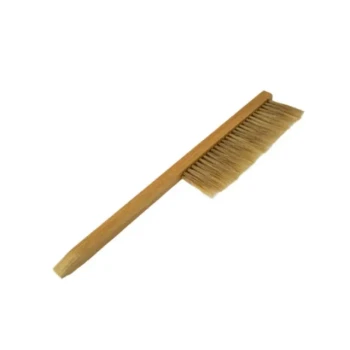In short, the primary advantages of a honey strainer are its simplicity, low cost, and effectiveness. It provides a straightforward way for any beekeeper, particularly hobbyists, to remove unwanted particles like wax, propolis, and other debris from their honey. This ensures a clean, clear final product without the need for expensive or complex machinery.
The true value of a honey strainer lies not just in filtering, but in enabling the accessible "crush and strain" extraction method. This approach makes it the cornerstone of honey processing for small-scale beekeepers who prioritize simplicity and affordability.

The Fundamental Role of a Honey Strainer
A honey strainer is a deceptively simple tool with a critical function. It acts as the gatekeeper between raw, freshly harvested honey and the clean, final product you want to put in a jar. Its advantages are rooted in this simplicity.
Achieving Clarity and Purity
The most obvious advantage is filtration. A strainer's mesh screen physically blocks particles from passing through with the honey.
This process removes bits of beeswax, bee parts, splinters of wood from the frames, and other hive debris that inevitably gets mixed in during harvest. The result is pure, visually appealing honey.
Unmatched Simplicity of Operation
There is virtually no learning curve to using a honey strainer. You simply place it over a clean, food-grade bucket and pour the honey through it.
This ease of use makes it an essential and approachable tool, especially for those just beginning their beekeeping journey.
Cost-Effectiveness for Small Operations
For hobbyists or beekeepers with only a few hives, a honey strainer is the most economical choice for processing.
It provides a necessary function for a fraction of the cost of mechanical equipment like centrifugal extractors or presses, making it the default starting point for anyone on a budget.
The Strainer's Place in Extraction
While a strainer can be used with any extraction method, its main advantage is realized when used as part of a low-tech, manual process perfect for small harvests.
The "Crush and Strain" Method
This is where the strainer becomes the star of the show. The process involves cutting the honeycomb from the frame, crushing it to release the honey, and then pouring the entire mixture into a strainer.
The honey drains through, leaving the wax and debris behind. This method is highly effective, minimizes honey waste, and requires no electricity or expensive equipment—just a bucket, a tool for crushing, and a strainer.
A Complement to Mechanical Extractors
Even beekeepers who invest in a centrifugal extractor still rely on strainers.
After the honey is spun out of the frames, it's standard practice to pass it through a fine-mesh strainer one last time. This final step catches any fine wax particles that the extractor may have dislodged.
Understanding the Trade-offs
While highly advantageous for its target user, the simplicity of a honey strainer comes with practical limitations. Understanding these trade-offs is key to knowing if it's the right primary tool for you.
Manual Labor vs. Automation
Using the crush and strain method is labor-intensive. Crushing comb and waiting for honey to drip through the strainer takes significantly more time and physical effort than using an automatic extractor.
Limitations of Scale
The crush and strain method is not practical for large-scale operations. For a beekeeper with dozens or hundreds of hives, the time commitment would be prohibitive, making a mechanical extractor a necessary investment.
Preservation of Natural Qualities
A key benefit often overlooked is that simple straining is a "cold" process. It preserves all the natural characteristics of the honey, including delicate aromas and beneficial pollen grains. This stands in contrast to some large commercial operations that may heat honey to make it filter faster.
Making the Right Choice for Your Goal
Your goals as a beekeeper will determine how you view the advantages of a honey strainer.
- If your primary focus is getting started with a few hives: A simple set of honey strainers is the most practical and affordable way to produce clean honey.
- If your primary focus is growing your operation: A strainer remains an essential tool for final filtering, but you will likely pair it with a mechanical extractor to save time.
- If your primary focus is producing pure, raw honey: The low-tech crush and strain method is superior, as it avoids the heat and high-speed forces that can alter honey's natural state.
Ultimately, the honey strainer empowers you to turn your raw harvest into a beautiful, finished product with minimal investment.
Summary Table:
| Advantage | Key Benefit | Ideal For |
|---|---|---|
| Simplicity | Easy to use, no learning curve | Beginner beekeepers |
| Cost-Effectiveness | Most economical processing tool | Hobbyists & small operations |
| Purity & Clarity | Removes wax, propolis, and debris | Producing clean, jar-ready honey |
| Method Flexibility | Enables 'crush and strain' extraction | Low-tech, raw honey production |
Ready to produce clean, pure honey with the right equipment?
HONESTBEE supplies beekeeping supplies and equipment to commercial apiaries and beekeeping equipment distributors through wholesale-focused operations. We provide the reliable, high-quality strainers and other tools that help beekeepers of all scales succeed.
Contact our team today to discuss your needs and get the equipment that supports your honey production goals.
Visual Guide

Related Products
- 10L Stainless Steel Electric Honey Press Machine
- HONESTBEE 72 Frame Industrial Electric Honey Extractor for Beekeeping
- 2 Frame Stainless Steel Manual Honey Spinner Extractor for Beekeeping
- Plastic Hand Crank 2 Frame Honey Extractor Low Price
- Honey Concentrating Vacuum Heating Thickening Machine Dehumidifier for Honey
People Also Ask
- How does the press method for extracting honey work? A Simple, Low-Cost Guide for Beekeepers
- What voltage options are available for stainless steel screw honey pumps? Choose the Right Power for Your Scale
- What are the benefits of using a honey press for Warré or Top Bar beehives? Maximize Your Natural Harvest
- What are the key features of a honey press? Maximize Yield with Durable, Efficient Extraction
- What are the unique characteristics of honey presses? Maximize Honey Yield for Small-Scale Beekeeping



















